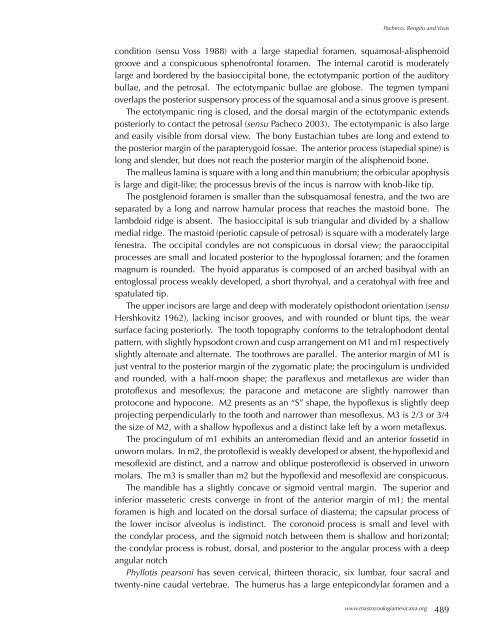therya-5_2
therya-5_2
therya-5_2
You also want an ePaper? Increase the reach of your titles
YUMPU automatically turns print PDFs into web optimized ePapers that Google loves.
Pacheco, Rengifo and Vivas<br />
condition (sensu Voss 1988) with a large stapedial foramen, squamosal-alisphenoid<br />
groove and a conspicuous sphenofrontal foramen. The internal carotid is moderately<br />
large and bordered by the basioccipital bone, the ectotympanic portion of the auditory<br />
bullae, and the petrosal. The ectotympanic bullae are globose. The tegmen tympani<br />
overlaps the posterior suspensory process of the squamosal and a sinus groove is present.<br />
The ectotympanic ring is closed, and the dorsal margin of the ectotympanic extends<br />
posteriorly to contact the petrosal (sensu Pacheco 2003). The ectotympanic is also large<br />
and easily visible from dorsal view. The bony Eustachian tubes are long and extend to<br />
the posterior margin of the parapterygoid fossae. The anterior process (stapedial spine) is<br />
long and slender, but does not reach the posterior margin of the alisphenoid bone.<br />
The malleus lamina is square with a long and thin manubrium; the orbicular apophysis<br />
is large and digit-like; the processus brevis of the incus is narrow with knob-like tip.<br />
The postglenoid foramen is smaller than the subsquamosal fenestra, and the two are<br />
separated by a long and narrow hamular process that reaches the mastoid bone. The<br />
lambdoid ridge is absent. The basioccipital is sub triangular and divided by a shallow<br />
medial ridge. The mastoid (periotic capsule of petrosal) is square with a moderately large<br />
fenestra. The occipital condyles are not conspicuous in dorsal view; the paraoccipital<br />
processes are small and located posterior to the hypoglossal foramen; and the foramen<br />
magnum is rounded. The hyoid apparatus is composed of an arched basihyal with an<br />
entoglossal process weakly developed, a short thyrohyal, and a ceratohyal with free and<br />
spatulated tip.<br />
The upper incisors are large and deep with moderately opisthodont orientation (sensu<br />
Hershkovitz 1962), lacking incisor grooves, and with rounded or blunt tips, the wear<br />
surface facing posteriorly. The tooth topography conforms to the tetralophodont dental<br />
pattern, with slightly hypsodont crown and cusp arrangement on M1 and m1 respectively<br />
slightly alternate and alternate. The toothrows are parallel. The anterior margin of M1 is<br />
just ventral to the posterior margin of the zygomatic plate; the procingulum is undivided<br />
and rounded, with a half-moon shape; the paraflexus and metaflexus are wider than<br />
protoflexus and mesoflexus; the paracone and metacone are slightly narrower than<br />
protocone and hypocone. M2 presents as an “S” shape, the hypoflexus is slightly deep<br />
projecting perpendicularly to the tooth and narrower than mesoflexus. M3 is 2/3 or 3/4<br />
the size of M2, with a shallow hypoflexus and a distinct lake left by a worn metaflexus.<br />
The procingulum of m1 exhibits an anteromedian flexid and an anterior fossetid in<br />
unworn molars. In m2, the protoflexid is weakly developed or absent, the hypoflexid and<br />
mesoflexid are distinct, and a narrow and oblique posteroflexid is observed in unworn<br />
molars. The m3 is smaller than m2 but the hypoflexid and mesoflexid are conspicuous.<br />
The mandible has a slightly concave or sigmoid ventral margin. The superior and<br />
inferior masseteric crests converge in front of the anterior margin of m1; the mental<br />
foramen is high and located on the dorsal surface of diastema; the capsular process of<br />
the lower incisor alveolus is indistinct. The coronoid process is small and level with<br />
the condylar process, and the sigmoid notch between them is shallow and horizontal;<br />
the condylar process is robust, dorsal, and posterior to the angular process with a deep<br />
angular notch<br />
Phyllotis pearsoni has seven cervical, thirteen thoracic, six lumbar, four sacral and<br />
twenty-nine caudal vertebrae. The humerus has a large entepicondylar foramen and a<br />
www.mastozoologiamexicana.org<br />
489



